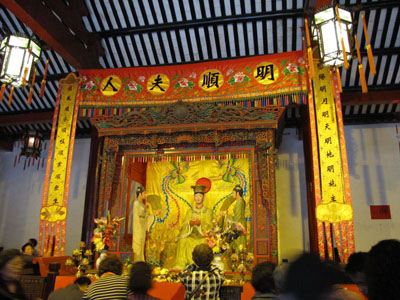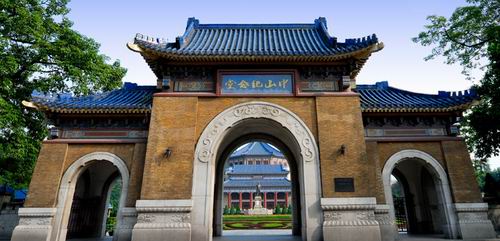The top four famous fruits of Guangzhou are banana, litchis, pineapples, and oranges. Other famous fruits include carambolas, papayas, longans and wampees. Green litchis, black olives and white olives from Zengcheng, litchi honey from Conghua, sugar cane and bananas from Panyu, sweet oranges from Luogang, and longans from Shixia, are also known far and wide for their flavors and quality.
Flowers
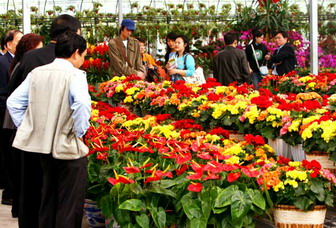
There are more than 150 varieties of flowers including the white orchid, Michelia, Aglaia odorata, gladiola, chrysanthemum, cumquat, and calamondin that contribute to Guangzhou's fame around the world.
Guangdong Embroidery
The origin of Chinese embroidery can be traced back over 2,000 years of history. The Beijing, Suzhou, Hunan and Guangdong schools of embroidery are the nation's top four that contribute to the fame of this specialty. Guangdong embroidery (also known as Cantonese embroidery) is a generic term for folk techniques found in Guangzhou and neighboring Nanhai, Panyu and Shunde. "All birds paying homage to the phoenix" and the double-faced "Golden Fish" are typical of Guangdong Embroidery.
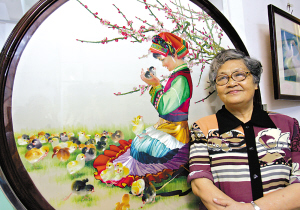
Guangdong embroidery is famous for its rich content, bright colors, vivid patterns, clear threads, and delicate stitches, and use on garments, articles for everyday use, ornaments, pictures, and costumes. Major professional makers of Guangdong embroidery include Guangzhou Embroidery Products Factory, Zhonghua Costume Craft Factory, and Guangzhou Machine Embroidering Factory.
Guangdong embroidery falls into four categories: floss embroidery, gold and silver thread embroidery (also known as Panjin embroidery and Dingjin), pearl embroidery, and machine embroidery. Its varieties have increased steadily in recent years yet, for example, there are no needle embroidery, brocade embroidery, machine embroidery, embroidered clothes, silk embroidery, pearl embroidery, and hand-woven embroidery categories included in the styles produced by Guangzhou houses. Pearl-embroidered footwear and evening wear are immensely popular in the international market, enjoying brisk sales in more than 50 countries and regions including Europe, the United States, Australia, and Asia.
Canton Enamel
Also known as Guangzhou Golden Colored Enamel, has a history of more than 300 years. It is a typically Eastern technique whereby enamels are painted onto the whole surface of copper, ceramics, and other earthenware pieces. Once the painting is completed, the pieces were heated to bond the enamel firmly to the surface of the object creating a colorful piece that exudes color and liveliness.
Each Canton enamel piece goes through seven steps: line drawing, color filling, gold painting, green filling, coloring, mouth gilding, and firing. Canton enamel pieces usually depict people, flowers, birds, beasts, fish and natural landscapes and they are classified as artistic enamel, household ornamental enamel, and craftwork enamel and are available in more than 500 varieties with over 2,000 floral patterns.
Jade Carving
The origin of Guangzhou jade carving can be traced back to the middle and late Tang Dynasties and dating to more than 1,000 years ago. Guangzhou jade carving is noted for its special "color retaining" technique, which helps retain the natural color of raw jade and improve the exquisite appearance of the jade.
Jade carving falls into two categories: jade jewelry and jade ornaments. Jade jewelry pieces are typically made of precious Burmese emerald jade and fall into three categories: sleek individual pieces, floral individual pieces and brackets. Jade ornaments mostly depict people, flowers, birds or beasts or are shaped into bottles, balls, boats, pagodas, or incense burners. The most exquisite form of jade carving is jade balls, with ingeniously carved small balls, each one placed inside larger ones and each of which has uniform thickness, can move freely, and features patterns of natural landscapes, flowers, people, fish, birds, and beasts. The most exquisite jade ball has 20 layers, forming an integral system.
Guangzhou South Jade Carving Factory is a professional maker of various types of jade carving products. Most local jade shops are located on Daxin Road, Wende Road, Changshou Road, Wenchang Road, and Daihe Road...all doing a booming business.
Wood Carving
Wood carving, a traditional folk technique in Guangzhou, is famous for its exquisite elegance .Wood carving falls into two categories: architectural ornaments and furniture carving. Architectural ornaments are mostly made of camphor wood and used on hallways, doors, windows, screens, and tables. The columns, beams, doors, windows and screens in the Qing-Dynasty Chen Clan's Temple (Guangzhou Folk Art Museum) epitomize the rich varieties and features of Guangzhou's wood craving technique.
The most sought-after forms of carved furniture are rosewood furniture and wooden cases. Rosewood furniture is a combination of China's traditional craving technique and advanced wood structural techniques, featuring ancient appearance, exquisite patterns, sturdiness, and durability constituting a highly prized artistic object for Eastern halls.
Lingnan Potted Plants
Lingnan potted plants are mostly made with locally sourced plants and rocks which, when they are subject to artistic treatment and carefully cultivated, reflect the natural landscapes in Lingnan. Lingnan potted plants represent one of China's top five schools and they are popular in the Pearl River Delta and the central and southern regions of Guangxi Province, but the most typical ones can be found in Guangzhou.
Lingnan potted plants are mostly subtropical or tropical evergreen, small-leaved plants sourced from the wilderness including such varieties as murraya jasminorage, Fujian tea plants, cape jasmine, hackberry, elm, and zanthoxylum nitidum.
Lingnan potted plants enjoy immense popularity with local people, decorating the living rooms and balconies of many local residences and lining park corridors and roads. They are also a major presence in potted plant markets. Guangzhou Xi Yuan (also called Western Garden) by Liuhua Lake is dubbed the "Home of Potted Plants", containing many masterly Lingnan potted plants which visitors can enjoy, feasting their eyes on fine examples and purchasing fine examples to take home.
Lingnan Painting
The Lingnan school of painting, initially known as "The Middle of the Road" school of painting, is a major part of China's painting history. Working with the slogan of "revolutionizing the arts", the school advocates a "middle of the road" position between traditional forms of Chinese expression and foreign painting and pushes for an integration of traditional and modern paintings. It places a high value on realistic representation of real life and on the reflection of the spirits of the era of Chinese painting, and strives to inject fresh energy into the genre. Highly prized Lingnan paintings include "Desolation at Jiangguan" by Gao Jiangfu, founder of the Lingnan school of painting; "Spring Rains over the Willow Pond" and "White Horses" by Gao Qifeng, and "Spring Over Lingnan" by Chen Shuren, all of which combine the exaggeration technique of the Japanese School and the gouache techniques of the Ju School of painting.
Ivory Carving
The origin of ivory carving can be traced back more than 2,000 years ago to the Jin Dynasty. Guangzhou's ivory carving techniques feature motifs depicting people, birds, beasts and flowers and carved ivory ornaments are common in the study of the literati.
Traditional ivory products include ivory balls, slabs and vases with ivory balls being the most sought-after in the genre. By technique Guangzhou ivory carving falls into two categories: round carving and hollowed carving. Round ivory carvings are mostly solid handiworks featuring patterns of people, animals and natural landscapes whereas hollow ivory carvings are primarily ivory vases, miniature floral towers, crab cages and ivory balls.
Guangzhou Ivory Carving Factory on Daxin Road is a leading professional ivory carver with a fine reputation at home and abroad.
Shiwan Brick Carving
Shiwan brick carving, popular in Panyu District, Guangzhou, falls into three categories: shallow relief carving, high relief carving and hollowed carving. Bricks used for carving are grey clay bricks of good quality chosen because such bricks are sturdy, not prone to crack yet easy to carve. Folk artists use chisels, wooden hammers, saws and drills to carve grey bricks into various shapes, including people, flowers, birds, and beasts, for ornamental purposes at entrances and on roof ridges, corners, walls, screens, upturned eaves, balusters, shrines and skylights in ancestral halls, temples and residences.
Olive Kernel Carving
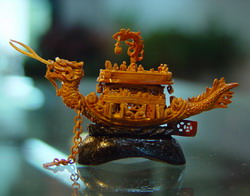
Olive kernel carving, an intricate artistic form, has been around for more than 300 years. Olive kernels used for this purpose are mostly black olive kernels from Guangdong, especially those from Xintang township, Zengcheng county. These kernels are of the right size for carving into miniature boats and other forms. Xintang Township is also the cradle of the olive kernel carving technique. In the Qing Dynasty, carved olive kernels were articles of tribute.
The most famous olive kernel carving in history is a carved miniature boat featuring "So Dongpo's night visit to Chibi" (Su Dongbo is a renown Chinese poet in ancient times) by Zhan Gusheng, a veteran carver from Xintang of the Qing Dynasty (1616-1911) who was dubbed the "King of Carving". He even carved a 537-character poem by Su Dongpo on the bottom of the boat. Carved figures on the boat are characterized by realistic expressions and lively gestures. This priceless carving masterpiece now sits in Zengcheng Museum.
The varieties of modern olive kernel carving products have increased from three at the outset, to total of more that 50 in modern times. Current forms including multi-level floral boats, hollowed crab cages, fishing boats casting nets, imperial palace lanterns, floral tower, ancient furnace, and chess pieces attract buyers from all over the world.
Shiwan Figurines
Guangdong Shiwan artistic pottery sculpting has a long history. Archeological findings suggest that this was a sizable industry in the Tang Dynasty. Early Shiwan pottery sculptures were mostly used on clan ancestral halls and temples and, since the mid-Qing Dynasty, they have primarily depicted people and the Goddess of Mercy and other figurines, enjoying immense popularity among local people.
The origin of Shiwan figurines can be traced back to the Qing Dynasty when pottery workers casually kneaded clay into various shapes after work as a form of amusement. Shiwan figurines generally feature historic, literary, dramatic and bureaucratic motifs and depict birds, animals and fish. They are a vivid representation of Lingnan folklore, exquisite, realistic and highly interesting.
Great efforts are being made to catalog these treasures, preserve prime examples and to continue these treasured arts in our city.
All materials marked with "source: English.gz.gov.cn" on this website (including but not limited to text, photographs, audio and video materials) are the copyrighted property of Guangzhou International (the official website of Guangzhou Municipality). Without prior authorization from Guangzhou International, any media, website, organization or individual shall not transmit, interlink, distribute or republish such materials in any form. Any media and website authorized to republish such materials shall mark them with "source: Guangzhou International (English.gz.gov.cn)". Infringement of these copyrights will result in legal action.

